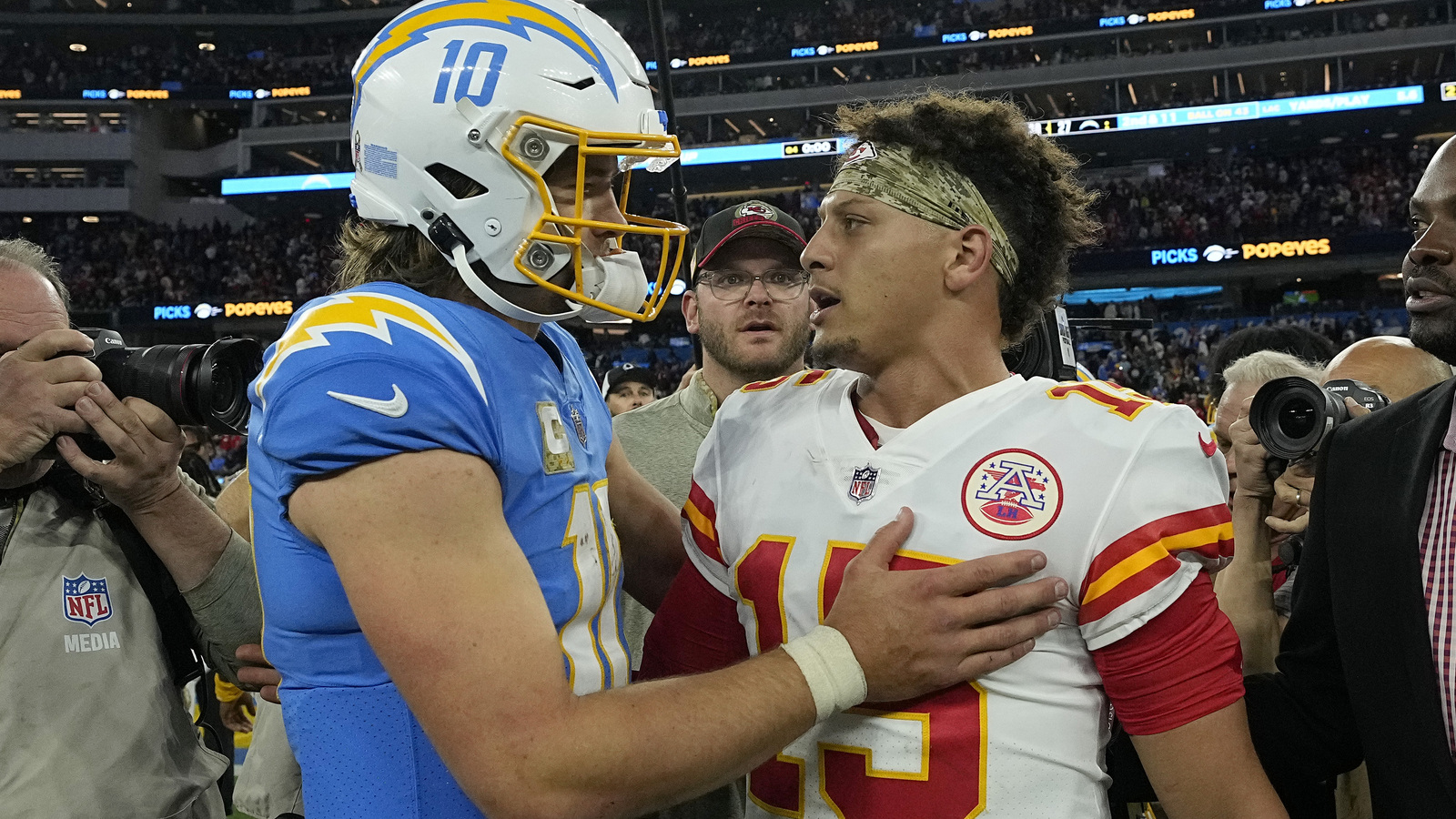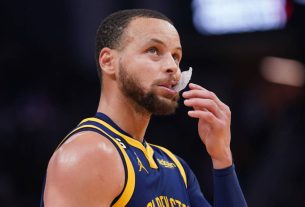With an aim to pinpoint when top talent crossed paths and when new arrivals created considerable depth, here are the Super Bowl era’s best quarterback divisions.
Kim Klement-USA TODAY Sports
More of a legacy pick than one based on top-tier production, this division featured two all-time greats and a former MVP just past his prime. Few on Drew Brees or Matt Ryan’s levels came through the AFC East during Tom Brady’s Patriots reign, and the Saints held off the new Buccaneers starter for a year with a regular-season sweep. Brees was in decline at 41 but still boasted a 24-6 TD-INT ratio without much Michael Thomas help, while Brady’s late-season surge ended with 40 TD throws — up from 24 in a down 2019 — and Super Bowl win No. 7. Teddy Bridgewater’s Carolina cameo also went better than Sam Darnold’s, though neither the Panthers nor Falcons were a threat.
2 of 22
Mid-1970s NFC East
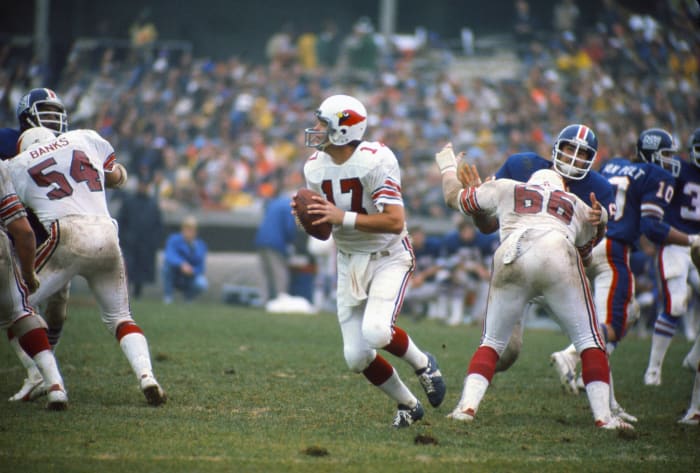
Focus on Sport/Getty Images
This period crests on St. Louis’ Don Coryell-Jim Hart partnership, which ran from 1973-77. The longtime Cardinals QB made four straight Pro Bowls during this stretch, elevating a division that saw the Eagles deploy the NFL’s touchdown pass leader (Roman Gabriel) in 1973 after an offseason trade. The Cowboys also kept Roger Staubach in the lineup full-time beginning in 1973. His backup — two-time Super Bowl starter Craig Morton — resurfaced on bad Giants teams after an in-season trade. Super Bowl VII Washington starter Billy Kilmer also ranked in the top 10 in passer rating in three of these years, despite moving into his late 30s.
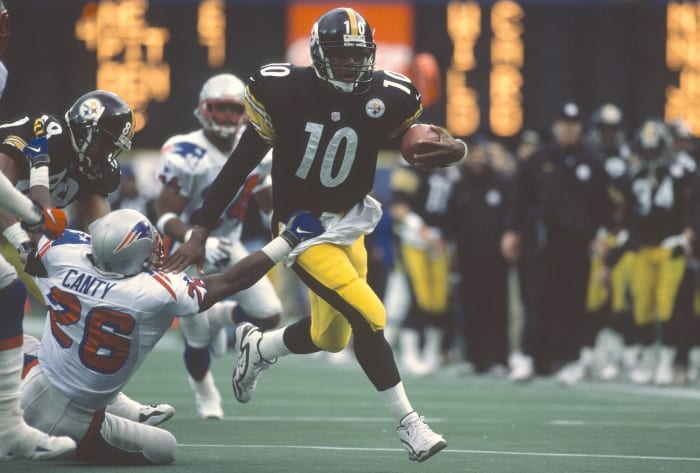
Focus on Sport/Getty Images
For a season, this five-Pro Bowler division boasted historic QB depth. The Steelers’ first Kordell Stewart starter year coincided with Vinny Testaverde’s final Ravens slate and Steve McNair’s first full-fledged Oilers starter campaign. These three synced up with Mark Brunell (Jaguars) and Jeff Blake (Bengals). No team lost double-digit games, and the Steelers and Jaguars punched playoff tickets. “Slash” led the Steelers to a home AFC championship game, while Brunell made the Pro Bowl. Testaverde had the Jets in the ’98 AFC title game, and McNair — a future MVP — started in the following year’s Super Bowl. A rare talent intersection here.
4 of 22
Late-1980s NFC West
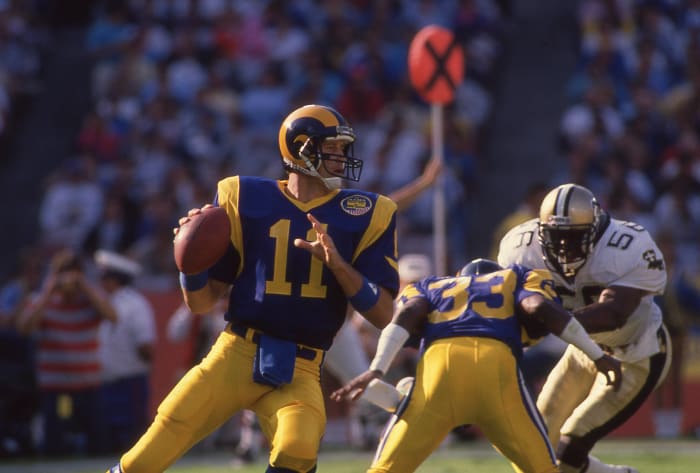
Owen C. Shaw/Getty Images
Jim Everett’s rise to the Pro Bowl level by 1988, when the young QB teamed with Henry Ellard and Flipper Anderson to redefine what was a run-oriented Rams offense, enhanced this division’s aerial capabilities. Ex-USFLer Bobby Hebert came along at this point, too, ranking in the top quartile in passer rating by 1989 and lifting a moribund Saints franchise. Falcons QB Chris Miller ensured all four NFC West passers were top-12 in rating in ’89. Five QBs in this division (counting Steve Young) eventually led teams to the playoffs. Of course, Joe Montana towered over his peers, both with and without Bill Walsh, crafting a second peak that included two more Super Bowl wins. The second of which came after a 49ers-Rams NFC championship tilt.
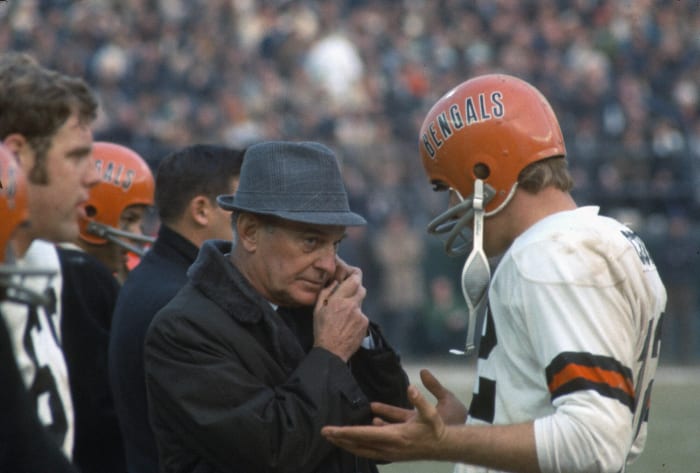
Focus on Sport/Getty Images
The Bengals began in a division featuring a Hall of Famer, a two-time MVP, and a perennial Pro Bowler. Separating this season’s Len Dawson-Daryle Lamonica-John Hadl division: Cincinnati rookie Greg Cook, a top-five pick and budding star. Paul Brown’s QB led the AFL in yards per attempt (9.4) and showed flashes of greatness during his lone healthy season. Dawson and Lamonica, who combined to play in three of the first four Super Bowls, had the Chiefs-Raiders rivalry at its height. The teams vied for the final AFL crown, a Chiefs road win. Hadl played 16 seasons, mostly with the Chargers, and was a six-time AFL All-Star or Pro Bowler.
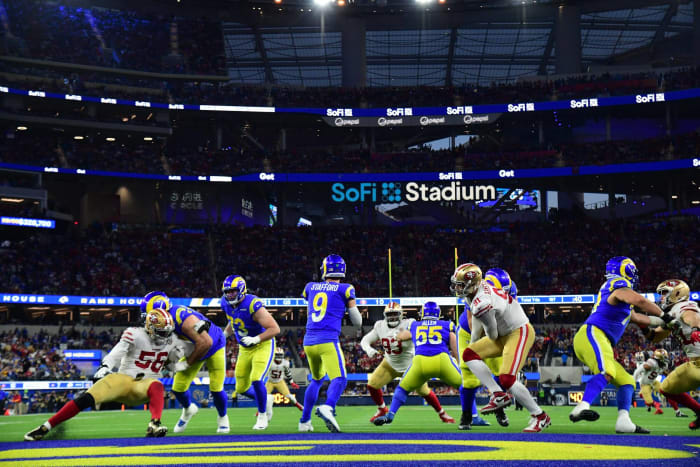
Gary A. Vasquez-USA TODAY Sports
The Russell Wilson-Matthew Stafford-Kyler Murray-Jimmy Garoppolo quartet lasted one year, capping its historical standing, but this division presented a high floor. Stafford elevated the Rams, proving his talent with a 50-TD, 6,000-yard (in 21 games) season that ended with the ex-Lion and Garoppolo deciding NFC supremacy. Just off the franchise-QB level, Garoppolo helped the 49ers to two NFC title games and led a do-or-die Week 18 drive in L.A. to move the 49ers into the playoffs. Wilson’s hand injury ended his Seattle run meekly, and Murray was brutal in his playoff debut. But one is a likely Hall of Famer and the other has two legit Pro Bowl invites in four years. Quite the QB one-off in 2021.

Tom Horak-USA TODAY Sports
Although the process took weeks to finalize, the Jets employ Aaron Rodgers after a familiar-looking trade with the Packers. Brett Favre’s successor will be a first-ballot Hall of Famer, and while Rodgers is probably a touch past his prime, he should still have a top-10 ceiling in 2023. Ruler of this division post-Tom Brady, Josh Allen is firmly in the top five at the position. Tua Tagovailoa has fervent supporters and showed star potential in a concussion-shortened 2022. Tua staying healthy could rocket this foursome to a new tier, and Bill O’Brien fixing Mac Jones would raise this quartet’s floor to a rarefied place.
8 of 22
Early-2010s NFC West

Ezra Shaw/Getty Images
Ground Zero for a new wave of offense, this period’s NFC West featured three straight Super Bowl starters (Colin Kaepernick, Russell Wilson). Both mobile QBs operated zone-read-based attacks capitalizing on athleticism; defenses did not offer reliable deterrence from 2012-13. Though Wilson was not yet a great passer, he and Marshawn Lynch kept the Seahawks’ dual-threat attack on top through 2014. The Seahawks-49ers 2013 NFC title classic elevates this group as well. Adding to this division’s appeal: the Cardinals’ 2013 trade for Carson Palmer. The rejuvenated 30-something turned around a struggling team post-Kurt Warner. Sam Bradford spent this span as the division’s other QB. Lacking receiving help, the injury-prone Ram had moments.
9 of 22
Late-1990s AFC East
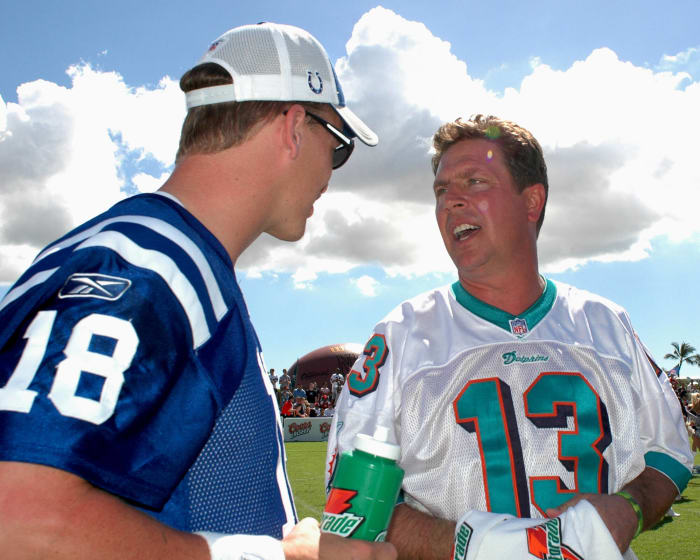
Al Messerschmidt/Getty Images
The timing did not align here, but for two seasons, this division housed two all-century-teamers at quarterback. Dan Marino was declining by the time Peyton Manning arrived, though the two put on a show in a 1999 Colts-Dolphins matchup. But this division sent four teams to the playoffs in 1998, with Vinny Testaverde lifting the Jets with a 29-touchdown pass year and Doug Flutie’s comeback transforming the Bills. This all came as Drew Bledsoe remained an upper-echelon QB. Manning’s rapid 1999 growth changed the division’s complexion, as Marino’s descent and Testaverde’s ACL tear lowered its ceiling.
10 of 22
2022-23 AFC North
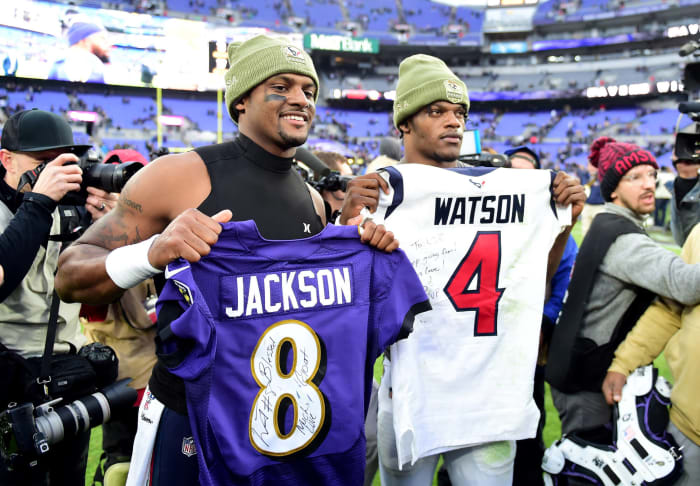
Evan Habeeb-USA TODAY Sports
Kenny Pickett produced an underwhelming rookie stat line, but his late-season form creates upward mobility for this group, which will be back en masse after the Ravens and Lamar Jackson reached an elusive extension agreement. Jackson and Joe Burrow headline this division, with the Bengals superstar swiftly becoming the division’s beltholder. Deshaun Watson’s 2023 form represents the wild card. The three-time Texans Pro Bowler-turned-controversial trade piece underwhelmed during his post-suspension Browns audition, but the outlier guarantee Cleveland needed to win those 2022 sweepstakes ensures he will be battling Burrow, Jackson and Pickett for a while.
11 of 22
Late-2000s NFC East

Rich Kane/Icon Sportswire
Eli Manning, Tony Romo, and Donovan McNabb combined for 14 Pro Bowls; the Eagles passer earned his sixth in this span. This tri-rivalry began when Romo usurped Drew Bledsoe in 2006. The Giants, Eagles, and Cowboys combined for six playoff berths from 2006-09; each of these teams beat a division rival in one of those brackets. Though McNabb was injured for Philly’s 2006 wild-card walk-off, he kept the team on a playoff plane post-Terrell Owens and led a run to the Super Bowl XLIII precipice. Romo’s 20s involved three Pro Bowls and a 2007 No. 1 seed. Manning spoiled that, piecing together a career-defining Super Bowl charge. Washington and first-rounder Jason Campbell could not keep up.
12 of 22
Late-1970s AFC West

Focus on Sport/Getty Images
Encompassing the 1977-79 period, when the Broncos acquired Craig Morton to end a near-two-decade playoff drought, the AFC West carried two Canton-bound passers and two other capable cogs. Ken Stabler ruled this division for most of the 1970s and remained elite into his early 30s, making the 1977 Pro Bowl and throwing 26 TD passes in 1979. Dan Fouts’ career took off when Don Coryell arrived during the 1978 season; the Chargers star’s four-year run as the NFL passing leader began in 1979. Posting a top-five passer rating in 1977, Morton piloted Denver to wins over ’70s powers Pittsburgh and Oakland en route to Super Bowl XII. Seattle’s Jim Zorn-Steve Largent connection was must-see as well.
13 of 22
Early-1980s NFC East
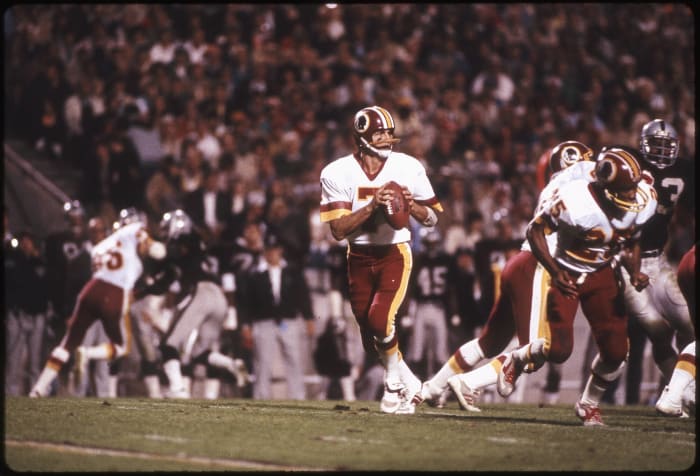
John W. McDonough/Icon Sportswire
The 1980 and ’82 NFC title games were all-NFC East affairs, each involving Roger Staubach’s successor. Danny White did not approach Staubachian heights, but he kept the Cowboys on the championship tier in the early ’80s. Joe Theismann headlined this division, leading Washington to the Super Bowl XVII title and winning MVP acclaim as conductor of a record-setting offense a year later. Fellow early-30s passer and future ESPN colleague Ron Jaworski did his best work in the early ’80s, piloting the Eagles to Super Bowl XV in his lone Pro Bowl season. Further bolstering this group: the Cardinals’ transition to Neil Lomax, who dropped a 4,600-yard season in 1984, and Phil Simms’ belated rise.
14 of 22
2009-10 NFC North
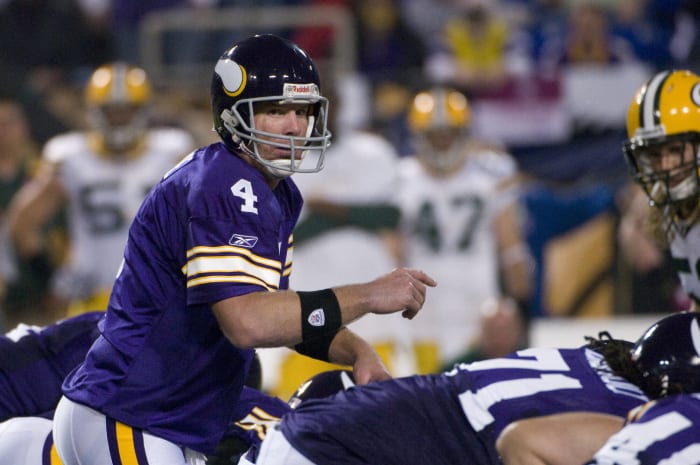
Jack Rendulich/Icon Sportswire
Three NFC North franchises booked NFC title game berths during this period. While the Jay Cutler-led Bears’ 2010 work helps this division’s cause, the Brett Favre-v.-Aaron Rodgers duels are why it resides here. The Jets released Favre’s rights after retirement No. 2, leading to his 2009 Minnesota arrival. At 40, Favre submitted a throwback season: a 33-7 TD-INT ratio, a Packers sweep, and the Vikings reaching the Super Bowl XLIV precipice. Rodgers grew into his A-plus version a year later, sweeping Favre and lighting up opposition en route to Super Bowl XLV MVP honors. Matthew Stafford displayed his talent early but battled injuries in his first two seasons. The future Super Bowl winner still adds to this division’s mystique.
15 of 22
Late-1980s AFC Central
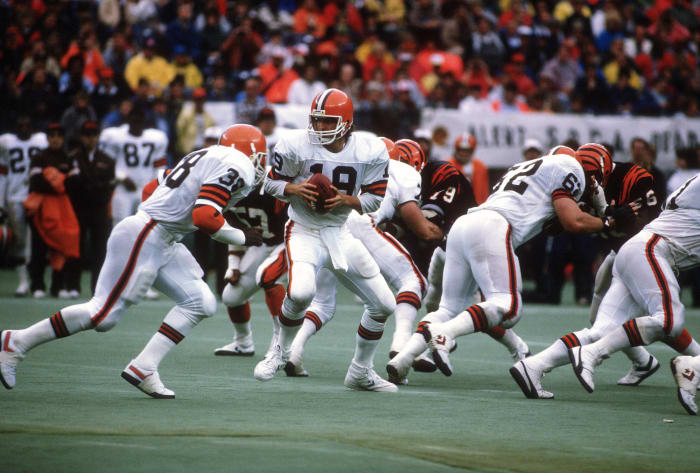
Focus on Sport/Getty Images
Each AFC Central team qualified for the divisional playoffs from 1987-89 — a competitive span when a Hall of Famer (Warren Moon), an MVP (Boomer Esiason), and a hometown star (Bernie Kosar) tussled. Moon started to click in 1987, when the Oilers’ run of seven straight playoff berths began, and the future passing champion led Houston to two close playoff wins. Kosar had the Browns in back-to-back AFC title games — “The”-game losses, but still — the first after a high-octane comeback over the Jets. Esiason’s 1988 represented the best work when the southpaw powered Cincinnati’s no-huddle offense to Super Bowl XXIII. A flawed Bubby Brister-led Steelers team also pushed the AFC champion Broncos in the 1989 playoffs.
16 of 22
Late-1970s AFC Central
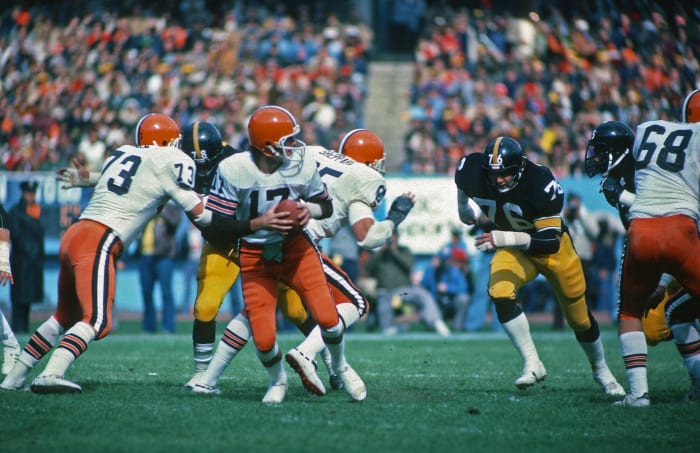
George Gojkovich/Getty Images
Three MVPs — Terry Bradshaw, Brian Sipe, and Ken Anderson — populated this division for nearly a decade, but its placement here stems from the Oilers also having a capable QB in Dan Pastorini. Taking advantage of rules the Steel Curtain’s dominance induced, Bradshaw trended upward in the late ’70s, winning the 1978 MVP and turning in two more strong Super Bowl showings. Sipe and Anderson showed their capabilities with MVPs in 1980 and ’81, respectively, but were in their primes at this point and led intermittently competitive Browns and Bengals teams. The Oilers stood as the Steelers’ top challenger, however. That period ended when Houston traded Pastorini to Oakland in 1980.
17 of 22
2022-23 AFC West
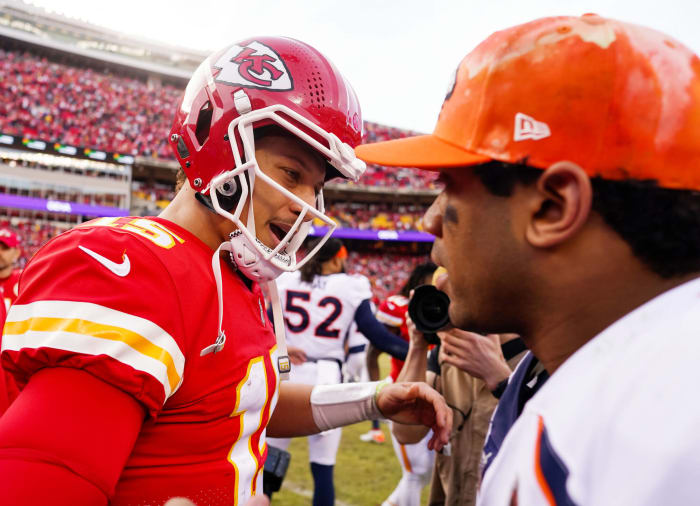
Jay Biggerstaff-USA TODAY Sports
Poised to lock down the No. 1 spot once the Broncos traded for Russell Wilson, this division hit a roadblock when the Wilson-Nathaniel Hackett honeymoon led to a shockingly quick divorce. Wilson’s Hall of Fame credentials — seemingly airtight in Seattle — may well ride (no pun intended) on the Sean Payton fit. Patrick Mahomes and Justin Herbert raise this division’s ceiling to a place few others in the divisional era could rival, with the Chiefs icon re-establishing himself as the undisputed best in the game today. The underachieving Chargers have an arm talent on that level, however. The Raiders will swap out one middle-class QB (Derek Carr) for another (Jimmy Garoppolo).
18 of 22
NFL Coastal Division

Bettmann/Getty Images
Concluding the NFL’s pre-merger era, the geographically unusual Coastal Division existed from 1967-69. The league moved from its long-running East-West setup and created a division housing the Colts, 49ers, Rams, and Falcons. In their infancy, the Falcons were a non-factor. But Johnny Unitas, Roman Gabriel, and John Brodie were here. Unitas and Gabriel won MVPs during this stretch, Unitas in 1967 and Gabriel in ’69. Brodie won MVP acclaim in 1970. Gabriel guided the Rams to a 32-7-3 record from 1967-69, helping keep an 11-1-2 Unitas-led Baltimore team out of the playoffs in 1967. The Colts were better in ’68, and emergency trade get Earl Morrall made the Coastal Division 3-for-3 in MVPs en route to Super Bowl III.
19 of 22
2010s NFC South, before Cam’s injuries

Todd Kirkland/Icon Sportswire
This division included back-to-back MVP winners, neither being the coalition’s best quarterback. Drew Brees’ prolific New Orleans career remained in high gear as Cam Newton (2015) and Matt Ryan (2016) quarterbacked stratospheric Super Bowl-bound offenses. Kyle Shanahan’s 2016 Atlanta offense’s 33.8 points per game remains eighth all-time, while Newton accounted for 45 TDs in a historic dual-threat season a year prior. Super Bowl 50 represented Newton’s cliff, with an injury-accelerated descent following. The Buccaneers struggled during these years but did land a high-variance maestro (Jameis Winston) in 2015.
20 of 22
AFC West feat. Joe Montana
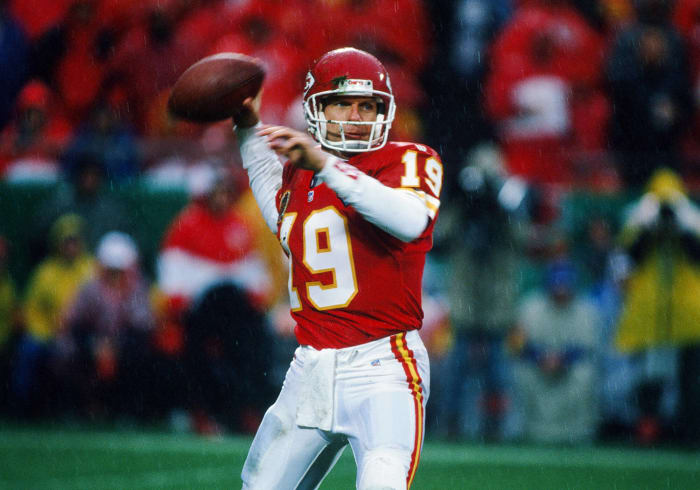
John Cordes/Icon Sportswire
The football gods offered a gift in 1993, when the Chiefs traded for Montana. The 49ers legend joined another all-century-teamer in John Elway, who had never lost to the Chiefs in Denver at that point. The Raiders also upgraded at QB in ’93, signing ex-Super Bowl winner Jeff Hostetler and voyaging past Elway’s Broncos in the playoffs. In 1994, Stan Humphries’ Chargers bested the Chiefs in Montana’s finale to secure the AFC crown. Montana’s injuries piled up, but he led Chiefs comebacks over the Steelers and Oilers in the ’93 playoffs. This group’s collective zenith came when Elway and Montana dueled on an October 1994 Monday night — Kansas City’s elusive win in Denver.
21 of 22
Mid-1990s AFC East

Jim Davis/The Boston Globe via Getty Images
The longstanding Dan Marino-Jim Kelly rivalry saw interesting competition join the Hall of Famers in 1993. The Patriots drafted Drew Bledsoe No. 1 overall, and the Jets traded for Boomer Esiason. The ex-Bengals MVP showed he still had gas in the tank by making the 1993 Pro Bowl; Bledsoe notched his first Hawaii trip a year later. The Colts advanced to the 1995 AFC title round behind free agency addition Jim Harbaugh, whose efficient season produced his only Pro Bowl. Kelly capped the Bills’ fourth straight Super Bowl berth in 1993, while Marino bounced back from an Achilles tear in ’94 to resume his prime, leading to a Week 1 duel with Bledsoe and the “Fake Spike” game against Esiason.
22 of 22
Early-1990s NFC East
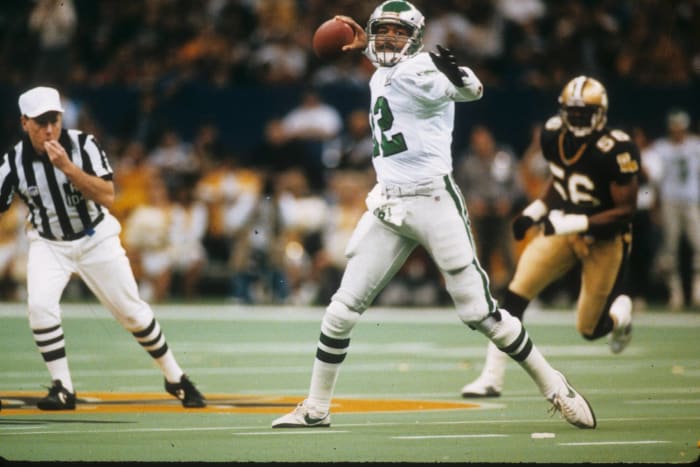
Joseph Patronite/Getty Images
Four straight Super Bowl champs came from this division, which included three Super Bowl MVP QBs, five Super Bowl starters, and six Pro Bowlers. Taking back the baton from Bo Jackson as the NFL’s most electric player, Randall Cunningham delivered an MVP-worthy 1990 season and bounced back from an ACL tear in ’92. Troy Aikman’s Hall of Fame ascent began in earnest in 1991, a year in which Mark Rypien’s Super Bowl XXVI MVP surge lacks the credit it deserves. Rypien led Washington to three straight playoff fields. The Giants toggled between Phil Simms and Jeff Hostetler during much of this time; Simms re-emerged with a strong 1993 finale. Even the doormat Cardinals employed future Super Bowl XXXIII starter Chris Chandler for three seasons. Depth-wise, this group reigns.
Sam Robinson is a Kansas City, Mo.-based writer who mostly writes about the NFL. He has covered sports for nearly 10 years. Boxing, the Royals and Pandora stations featuring female rock protagonists are some of his go-tos. Occasionally interesting tweets @SRobinson25.
